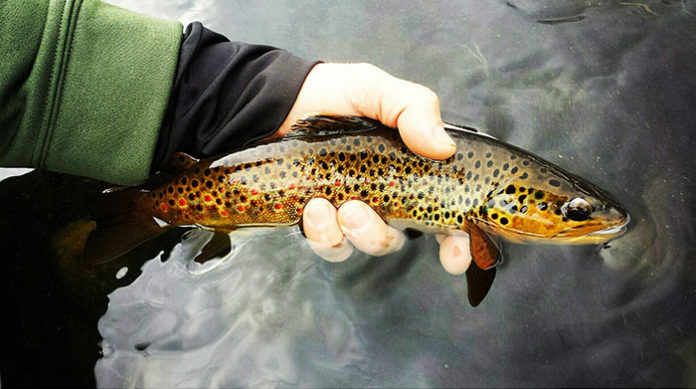Written by: Josh Williams
Winter trout often key on midges near or on the surface.
All photos by Josh Williams
Winter fishing in tailwaters can be both very fun and very frustrating. Although the absence of fair-weather fishermen means less angling pressure, you still have to deal with cold weather and its biological effects. For instance, the swarms of mayfly hatches are but a dream and your fingers struggle for dexterity as you try to tie on that small fly on light tippet.
However, because tailwater trout live in a relatively constant temperature environment, they don’t become as lethargic as non-tailwater trout during winter. Keep in mind, though, that tailwater trout do become more easily spooked and less apt to move out of feeder lanes in winter. That’s why you need a smaller tippet, slower tempo, and accurate casts that present flies directly over feeding fish. Although most of a trout’s diet in winter consists of subsurface insects, a good midge population will cause the fish to focus on these tiny insects.
We all know how successful patterns such as the Zebra Midges can be in tailwaters. But there are frustrating times when the trout start sipping subtly on top and will refuse your subsurface presentation on every drift. This is the time for a dry-fly midge pattern. One problem with fishing tiny dry flies is following the fly through the drift. Reflective glare (especially at dusk and dawn), foam lines, and the minute size of the fly are all fighting against you. The first little ripple your fly goes through sends you into a panic trying to locate the fly again. Just when you zero in on it, it has already passed by the slot of feeding fish.

A big midge hatch gets winter trout excited.
With practice, most anglers will learn to become more efficient in their tiny dry game. Watching naturals drift through is a valuable approach every angler should pay close attention to. You can learn the speed and route of the drift, thus helping you have a better understanding of where your fly will be should you lose sight of it temporarily. Another great tactic is to use a pattern that is easier to see.
I wanted an attractor midge pattern that was easy to follow without sacrificing size. That’s why I created Josh’s Reaper midge. Flashy wings offer a great visual aid for the angler, as well as a nice wing silhouette for the trout. The hackle thorax holds the front of the fly on the surface tension. The flashy braided-thread abdomen will penetrate the surface tension. Combining these two elements in this pattern on the Orvis Tactical Wide Gap Hook brings about a posture slightly angled in the water. This posture mimics a freshly emerged midge preparing to fly, a cripple, or even an egg-laying female.
Changing things up to a straight shank, a dry-fly hook will keep the body more above surface, emulating a spent adult. Hot spots can sometimes help your imitation compete with naturals for attention. For that reason, I use UV dubbing on the thorax. The braided thread comes in many color choices. This allows it to be tied with natural colors to match he hatch, or flashy bright colors making it an attractor pattern. The combination of these features allow for a great midge attractor pattern that’s easy to see for both the trout and the angler.

Josh’s Reaper Midge
Hook: Orvis Tactical Wide Gap Hook or dry-fly hook, sizes 16-22.
Thread: Black, Veevus 8/0 or 10/0.
Abdomen: Veevus Iris Thread in color of choice.
Wing: Pearl Krystal Flash.
Hackle: Grizzly.
Thorax: UV Ice Dub in pink, purple, or orange.
Note: Hackle will need to be sized accordingly. For really small
midges, take some of the Iris Thread strands apart so as not to
bulk up the abdomen too much.
Josh Williams is a guide and fly tier from Virginia. We featured his unique story and his most popular pattern in a post titled “The Art of Overcoming Obstacles.”
Credit: Source link































